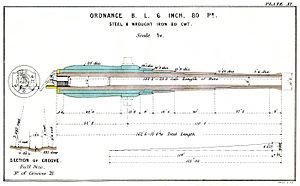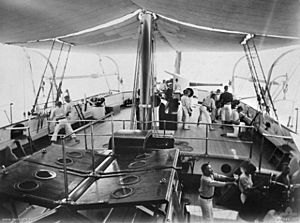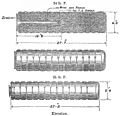BL 6-inch 80-pounder gun facts for kids
Quick facts for kids Ordnance BL 6-inch 80-pounder Mk I |
|
|---|---|

Gun from HMAS Protector at Birkenhead, South Australia, August 2011
|
|
| Type | Naval gun Coast defence gun |
| Place of origin | United Kingdom |
| Service history | |
| In service | 1880–1943 |
| Used by | Royal Navy Australian Colonies |
| Production history | |
| Designer | Elswick Ordnance Company |
| Manufacturer | Elswick Ordnance Company |
| Variants | Mk I |
| Specifications | |
| Mass | 80 or 81 cwt (4 tons) |
| Barrel length | 153 – 156 inches |
|
|
|
| Shell | 80 pounds (36.29 kg) Palliser, Shrapnel, common |
| Calibre | 6-inch (152.4 mm) |
| Breech | 3 motion interrupted screw. Elswick cup obturation |
| Muzzle velocity | 1,880 feet per second (573 m/s) |
| Maximum firing range | 8,000 yards (7,300 m) |
The BL 6-inch 80-pounder gun Mk I was an important early naval gun. It was one of the first large guns made in Britain that loaded from the back (breechloading). Before this, most big guns loaded from the front (muzzle-loading). This gun was designed in 1880 and used old-style gunpowder for firing.
Contents
What Was the Mk I 80-pounder Gun?
The Mk I gun weighed about 80 cwt, which is about 4 tons. It was designed by a company called Elswick Ordnance. When it was first made, it wasn't very strong. It could only fire a projectile that weighed 80 pounds (about 36 kilograms).
The gun was built with a steel barrel. Strong wrought-iron coils were shrunk over the barrel to make it tougher. Only a few of these guns were given to the British Royal Navy. Most were later replaced by newer, stronger versions.
Some Mk I guns that stayed in British service were made stronger. They had extra "chase hoops" added around the barrel. The barrel was also made a bit shorter to help balance the gun better. After these changes, the gun was called the 81 cwt Mk I gun.
The part of the gun where you loaded the shell, called the breech, turned to the left to lock. This was different from other British guns made by the Royal Gun Factory, which usually locked by turning to the right.
These guns were often called "6-in. 81-cwt B.L.R." in old books. The official name was "80-pounder BL." This helped people know it was different from later 6-inch guns that fired heavier, 100-pound projectiles.
The 80-pounder Gun in Australia
Many Australian colonies and New Zealand bought their own 6-inch guns. They bought them directly from companies like Elswick Ordnance. These guns were similar to the original British Mk I 80 cwt gun. They also fired an 80-pound projectile.
These guns were used on several gunboats in the Australian colonial navies:
- HMQS Paluma
- HMQS Gayundah
- HMCS Protector
- HMVS Victoria (from 1884)
- HMVS Albert (from 1884)
They were also placed on armed ships used in the harbor in Victoria, Australia:
- Gannet (a tugboat)
- Batman (a hopper barge / dredge)
- Fawkner (another hopper barge / dredge)
Ammunition
See also
- List of naval guns
Surviving examples
You can still see some of these old guns today:
- One 4-ton 80-pounder gun is at Fort Glanville, in Adelaide, South Australia.
- Another 4-ton 80-pounder gun is in the Bundaberg Botanic Gardens, in Bundaberg, Queensland, Australia.
- A restored gun from HMAS Protector is outside a Naval Reserve Cadets building in Birkenhead, Adelaide.
- The back gun from HMQS Paluma is at the Treloar Centre, part of the Australian War Memorial in Canberra.





